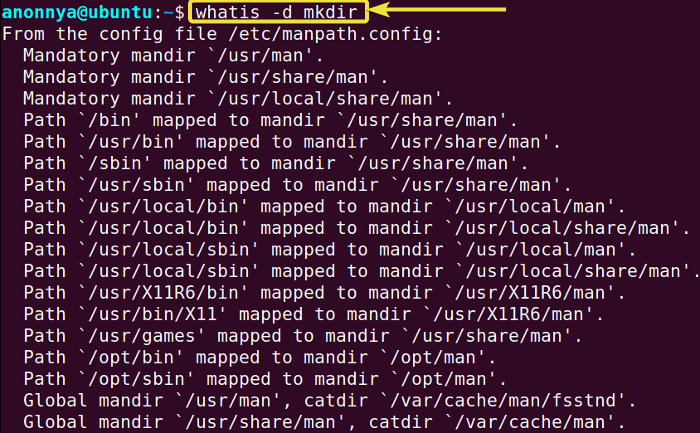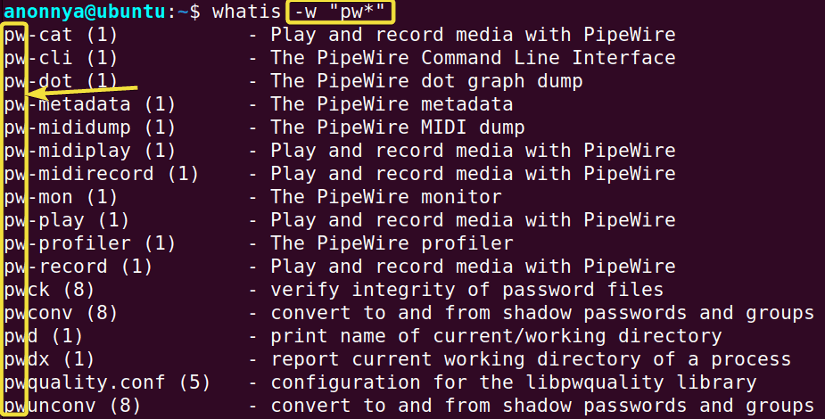FUNDAMENTALS A Complete Guide for Beginners

The whatis command in Linux provides the one-line man page description of keywords. Each command in Linux has some descriptive information within it. And, the whatis command searches for the Manual Page that matches the given keyword passed as an argument and outputs its description to assist users in getting to know the specified command in brief. However, while using special or wildcard characters, you must quote the name or use escape (\) to stop the shell from interpreting them.
In this article, I will explain various applications of the whatis command with 12 practical examples.
The Linux “whatis” Command Syntax
The syntax of the whatis command in Linux simply contains single or multiple options and then the desired Keywords.
whatis [OPTION]... KEYWORD...The Linux “whatis” Command Options
The whatis command in Linux offers multiple options to enhance user experience. Below you will find the most useful options of the command. For further details, you can always look at the man page.
man whatis|
Options |
Description |
| -d/–debug | Displays debugging messages. |
| -l/–long | Disable trimming output to the terminal width. |
| -L/–locale | Searches in the defined locale. |
| -M/–manpath | Set Manual Page search path. |
| -r/–regex | interprets the given name as a regular expression. |
| -s/–section | Search only in specified sections. |
| –usage | Print a short usage message. |
| -v/–verbose | Display verbose warning messeges. |
| -w/–wildcard | Search keywords with wildcard characters. |
12 Examples of the “whatis” Command in Linux
The whatis command is a convenient command to learn about the KEYWORDs associated with Linux. Some of the most useful applications of the whatis command have been illustrated below with 12 practical examples.
Example 1: Displaying a Short Description of a Keyword Using the “whatis” Command in Linux
You can learn about any command or keyword briefly by using the whatis command in Linux. It will provide a single-line description found on the man page of the associated keyword. In this example, I will display the short description of the pwd command. You can do the same by running the following command:
whatis pwdIn the given image, you can see that I have shown the description of the pwd command.
Example 2: Displaying Short Description of Multiple Keywords Using the “whatis” Command in Linux
You can view the short description from the man page of multiple keywords at the same time using the whatis command in Linux. In this example, I will show you the definition of the pwd, touch, and mkdir commands. To do the same, type the below command in the prompt and press ENTER:
whatis pwd touch mkdirIn the following image, you can see that I have shown the short descriptions of the desired commands.
Example 3: Access Debugging Information of a Keyword Using the “whatis” Command in Linux
You can display debugging information of a keyword by using the whatis command in Linux. To achieve this result you will need to use the -d option. In this example, I will be displaying the debugging messages of the mkdir command. You will be able to do the same by executing the command below:
whatis -d mkdirIn the next images, you can see that I have shown the debugging information of the mkdir command.
Similar Readings
- The “man” Command in Linux [6 Practical Examples]
- The “history” Command in Linux [6 Practical Examples]
- The “cal” Command in Linux [7 Practical Examples]
- The “bc” Command in Linux [10+ Practical Examples]
Example 4: Displaying Verbose Details of a Keyword Using the “whatis” Command in Linux
You can view a verbose description of a command by using the whatis command in Linux with the option -v. In this example, I will display the verbose description of the touch command. For a similar output, run the following command:
whatis -v touchIn the image below, you can see that I have shown the verbose description of the touch command.
Example 5: Extracting Every Description Containing the Specified Keyword
You can search for any keyword short description that contains the specific name using the whatis command in Linux. You can do so by using the option -r which interprets the given name as a regular expression. In this example, I find all the keywords and descriptions that have the keyword pwd. To do the same, run the command below in the prompt:
whatis -r pwdIn the following image, you can see that I have shown the short descriptions of all the commands containing the name “pwd”.
Example 6: Searching for a Keyword Description With Wildcard Characters
You can search for descriptions of keywords that contain certain characters by using the whatis command in Linux with the option -w. With this -w option, you can apply wildcard characters for searching. In this example, I will search for keywords that start with the string “pw”. To indicate any other string after “pw” I will use the wildcard character “*”. You can get the same results by running the command as follows:
whatis -w "pw*"In the given image, you can see that I have found all the keywords and their descriptions that start with “pw”.
Example 7: Disabling Trimmed Output
The whatis command in Linux generally truncates the output to the terminal width of one line. You can disable this trimming of the description using the -l option along with the command and eventually fit the whole sentence of that description. In this example, I will demonstrate disabling the trimming of the result by showing the short description of the cat command. You will be able to do the same by running this command below:
whatis -l catIn the image below, you can see in the 1st command without the -l option the output was truncated. But in the 2nd command when applied with the -l option you can get the full description.
Example 8: Searching For Keyword Description in the Specified Manual Section
When you’re searching for a keyword description using the whatis command in Linux, you can specify certain section numbers of the man page to look for the description. You can pass the section number by using the option -s. In this example, I will search for the man command description in sections 1 and 7 of its man page. Run the command below to do the same:
whatis -s 1,7 manIn the following image, you can see that I have displayed the description of the man command from the specified sections.
Example 9: Searching for Keyword Description in Other Operating System’s Manual Page
You can get access to other operating systems’ Manual Pages using the whatis command in Linux with the option -m. You must provide the specified system’s name along with the option. In this example, I will search for the touch command in NewOS‘s Manual Page. To achieve the same you may run the given command:
whatis -m NewOS touchIn the given image, you can see that I have shown a short description of the touch command from the NewOS‘s Manual Page.
Example 10: Searching for Keyword Description in an Alternate Set of Manual Page Hierarchies
The whatis command in Linux by default looks for the short description in the $MANPATH environment variable. You can specify an alternate set of colon-delimited manual page hierarchies to search in using the –M option with this command. In the below example, I will set the search path to /lib/touch to get the description of the command touch:
whatis -M --manpath=/lib/touchIn the following image, you can see that the output did not return any useful output as the does not contain the description of the touch command.
Similar Readings
- The “cron” Command in Linux [3 Practical Examples]
- The “crontab” Command in Linux [10 Practical Examples]
- The “date” Command in Linux [8+ Practical Examples]
- The “ncal” Command in Linux [8 Practical Examples]
Example 11: Directly Supplying a Keyword to the “whatis” Command
The whatis command in Linux generally determines the current locale by calling another function and checking various environment variables. You can directly supply a locale string to the whatis command using the -L option. In this example, I will directly send the string “pwd” to the whatis command. You may run the following command to do the same:
whatis pwd -L localeIn the following image, you can see that I directly supplied the pwd command to the whatis command to find its short description.
Example 12: Displaying a Usage Message Using the “whatis” Command in Linux
You can display a short usage message of the whatis command with the help of the --usage option. In this example, I will be displaying the usage message on my terminal. You will be able to view the same message after running the following command:
whatis --usageIn the below image, you can see that I have displayed a short usage message of the whatis command.
Conclusion
In this article, I presented the usefulness of the whatis command in Linux with 12 easy and practical examples. Using these examples, you will be able to utilize this command to learn more about the available keywords on the Linux distribution. I hope this writing will enrich your experience with the command line.
People Also Ask
How to use the whatis command in Linux?
Using the whatis command in Linux is very easy. Open the system terminal and type the command whatis followed by the name of the tool or command as its parameter. For example, to get the one-line description of the cp command, run the following command:
whatis cpDoes the Linux whatis command have the -help option?
Yes, it has. If you get stuck at some point in using the Linux whatis command, you can use the -h option with the command to get help. To display help on the terminal, run the following command:
whatis -hYou can also use the command whatis –help to do the same.
Can the Linux whatis command search for keywords or tools other than commands?
Yes. The whatis command in Linux not only prints the brief description of any mentioned commands but also provides information on functions. For example, run the following command to display a single-line definition of the printf function:
whatis printfOutput:
“format and print data”
How do I know the current version of the whatis command in Linux running on my system?
Just run the whatis -V command and get to know the version information that is currently running on your system. You can also use the –version option to achieve alike output.
Similar Readings
- The “neofetch” Command in Linux [12+ Practical Examples]
- The “tree” Command in Linux [14 Practical Examples]
- The “whereis” Command in Linux [10 Practical Examples]
- The “which” Command in Linux [3 Practical Examples]
- The “at” Command in Linux [7 Practical Examples]
- The “tee” Command in Linux [4 Practical Examples]













